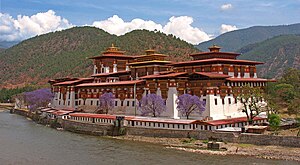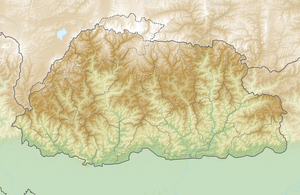Punakha Dzong
| Punakha Dzong | ||
|---|---|---|
| Alternative name (s): | Pungtang-Dechen-Photrang-Dzong | |
| Creation time : | 1638 | |
| Castle type : | Dzong (monastery castle) | |
| Geographical location | 27 ° 34 '55 " N , 89 ° 51' 47" E | |
|
|
||
The Punakha Dzong , also known as Pungtang-Dechen-Photrang-Dzong what "Extremely awe-inspiring Dzong Palace of Happiness" means is a Buddhist monastery fortress ( Dzong ) in District Punakha in Bhutan and serves as the administrative center of the district . Built by Shabdrung Ngawang Namgyel from 1637 to 1638, this dzong is the second oldest and at the same time the second largest monastery castle in Bhutan and one of the most impressive buildings in the country. The Punakha Dzong was the administrative center and seat of the government of Bhutan until the capital of the country after Thimphu in 1955 was relocated.
The monastery castle preserves the holy relics of the southern Drugpa line of the Kagyu school of Tibetan Buddhism , including the Rangjung Kasarpani and the sacred legacy of Ngawang Namgyel and Tertön Pema Lingpas .
A group of five Dzong, including the Punakha, was in the 2012 Tentative List for World Heritage in Bhutan added. This list contains the objects that the government of Bhutan intends to propose to the World Heritage Committee for inclusion in UNESCO World Heritage .
geography

Unlike the other dzongs in the country, the Punakha Dzong is not located on a hilltop or hill, but in the middle of the Punakha-Wangdue Valley, at the confluence of the two rivers Pho Chhu (father) and Mo Chhu (mother), in front of you impressive mountain scenery.
The sources of Mo Chhu are in the northern mountains of Lighsi and Laya in Bhutan and Tibet . The Po Chhu is formed by glaciers in the Lunana region of the Punakha Valley. Below the confluence of the two rivers, the combined river, now called Puna Tsang Chhu or Sankosh, continues through the Wangdue Phodrang district , crosses the border to India at Kalikola and finally flows into the Brahmaputra .
Because of the healthy climate of the region, Punakha became the winter capital of Bhutan. The head of the Bhutanese clergy and his entourage spend the winter months in this dzong. Jacaranda trees grow around the dzong and bloom in light purple in spring.
history
According to a local legend, the sage Padmasambhava predicted that "a person named Namgyal would come to a hill that looked like an elephant." Shabdrung Ngawang Namgyel found the top of the hill, which, as predicted, resembled an elephant's trunk, and built the dzong in 1637 and 1638.
Another legend tells how the architect Zowe Palep received a dream image after the Shabdrung instructed him to go to sleep under a small structure. This structure, which housed a Buddha statue , was known as Dzong Chug, which means small dzong. In his dream, inspired by the psychic powers of the Shabdrung, he received a clear vision of a palace for Guru Rinpoche . The vision impressed itself so clearly on the architect's mind that it enabled him to design a plan for the dzong and - without putting the vision on paper - to implement the building anyway. Based on the architect's dream vision, construction began on the site of the Dzong Chug in 1637. The construction was completed in 1638. At this time, as a result of his continued efforts to unite the country, Ngawang Namgyel became the first leader of a unified Bhutan.
The dzong was inaugurated under the name Pungthang Dechen Phodrang . In 1639, a memorial chapel was set up to hold the weapons that were captured when the Bhutans repulsed the Tibetans at this point . The Shabdrung also established an order of 600 monks who had been brought from Cheri Gompa in the upper Thimphu Valley. The Shabdrung lived here in this dzong until his death.
The peak on the roof of the Utse , the central tower of the dzong, was added in 1676 by Gyaltsen Tenzen Rabgye , the abbot of the dzong . Further additions followed from 1744 to 1763 under the rule of Sherab Wangchuck . The great thangka , known as the Chenma Thoundral des Shabdrung, was donated to the Dzong by the Desi . The thangka is shown once a year during the tshechu . The 7th Dalai Lama donated the copper roofs for the dzong.

Several fires damaged the Dzong between 1750 and 1849. The earthquake of 1897 caused severe damage. The dzong partially burned down in 1986, but was quickly rebuilt completely. It is considered an outstanding example of monastery and fortress architecture in Bhutan.
The Wangchuck dynasty has ruled the country since 1907. In the same year the Punakha Dzong was the coronation site of Ugyen Wangchuck for the first Druk Gyalpo . At that time, Punakha was the capital of Bhutan. Three years later a treaty was signed in Punakha, according to which the British refrained from interfering in the internal affairs of Bhutan and in return the Bhutans left their foreign affairs representation to the British. On October 13, 2011, the wedding between Druk Gyalpo Jigme Khesar Namgyel Wangchuck and his fiancée Jetsun Pema was held in the Punakha Dzong .
architecture
The dzong is part of the Drugpa line of the Kagyu school of Tibetan Buddhism in Bhutan and was established as the embodiment of Buddhist values. It is one of the 16 dzongs that were built under the rule of the Shbdrung between 1594 and 1691.
The six-storey building is 180 m long and 72 m wide and has three courtyards (Dochey) and a central tower (Utse) . Rammed earth , stone and wood were used for the construction .
The defenses to protect against enemy attacks consist of steep wooden stairs and a heavy wooden gate that is closed at night. After the damage from the fire in 1986, a large prayer hall was also built.
The administrative offices of the dzong, a very large, whitewashed stupa and a bodhi tree are located in the first courtyard. Also in the first inner courtyard, on the far left, are a stone embankment and a chapel dedicated to the Queen of the Nagas . The living quarters of the monks are located in the second courtyard, the Utse is located between the first and second courtyards. The buildings in the second courtyard include two historic halls; one is dedicated to Ugyen Wandchuck, the later king, the other hall is the one in which the king was awarded the Knight Commander of British India in 1905 by John Claude White . The third courtyard is at the southern end of the dzong, where the relics of Pema Lingpas and Ngawang Namgyel are kept. The Machey Lakhang in the third courtyard was completely refurbished in 1995 and contains the reliquary with the well-preserved, embalmed body of the Shabdrung. Machey literally means sanctified embalmed body . This lakhang is not open to visitors. However, this place is visited by the King and Je Khenpo , mainly to receive blessings before taking up their offices.
Flash floods from dam breaks in glacial lakes in the upper part of the Punakha Valley are common in the Mo Chhu and Pho Chhu rivers. In the past, such floods have repeatedly damaged the dzong, for example in 1957, 1960 and 1994. In 1996, a flash flood from Pho Chhu damaged the large stupa and resulted in several deaths. Fires and earthquakes also add to the problems with maintaining the dzong.
After extensive renovation work was carried out according to the Zorig Chusum tradition, an old handicraft tradition of wood carving, stonemasonry and metalwork, painting and other arts, the Dzong now has several new lakhangs, over 200 new religious images and a few other treasures. An initiation ceremony known as the Rabney Ceremony , performed by His Holiness the Je Khempo and the monks of Dratshang, the central monastic body, was held from May 13-15, 2004. This renovation work was largely funded by the Government of India . After the complete restoration of the dzong to its old glory, remarkable pictures, statues and thangkas will be shown there, including wall paintings from the reign of the second Druk Desi, which depict the life story of the Buddha. There are also gilded statues of the Buddha, Guru Rinpoche and the Shabdrung as well as gilded panels and columns.
A wooden cantilever bridge that crosses the Mo Chhu was built along with the dzong in the 17th century. This bridge was washed away by a flash flood in 1958 and rebuilt in traditional style from 2006. The new construction of the Punakha Bridge with a cantilever span of 55 m was completed in 2008. On the occasion of the inauguration, Prime Minister Jigme Thinley emphasized that the new bridge was an essential contribution to the anniversary celebrations of “100 years of the Wangchuck monarchy and the coronation of His Majesty King Jigme Khesar Namgyel Wandchucks in the Punakha Dzong”.
Temple festivals
The Demoche is the annual temple festival held on the Dzong, which is mainly attended by people from the villages and remote areas of the district. The ranking or "self-made" image of Avalokiteshvaras , which is kept in the Utse , is shown during the festival. There are some impressive performances during the five-day festival, also known as the Punakha Festival, which takes place in February or March. An important performance is the depiction of the invasion of 1639 when the Tibetans were repulsed. This theatrical performance, which was introduced by the Shabdrung, depicts the alleged throwing of a relic into the Mo Chhu.
On the final day of the temple festival, an image of the Shabdrung is displayed, followed by a dance performance in the main courtyard by 136 dancers dressed as warriors. The performance ends with the dancers descending the entrance stairs, whistling and shouting exuberantly. Thereupon the monks, led by the Je Khenpo des Dzong, move to the bank of the Mo Chhu with a lot of noise. The Je Khenpo then throws oranges into the river, which can be understood as Rangjung Kharsapani as a sacrifice to the Nagas who live under the river bed. After this act, traditional mask dances are performed on the grounds of the dzong, commemorating the establishment of the dzong.
Another rite that is celebrated every year is called Lhenkey Dungchhur and is used to worship dead souls.
literature
- Françoise Pommaret: Bhutan . Edition Earth • Travel Guide. 11th edition. Edition Temmen, Bremen 2013, ISBN 978-3-86108-810-3 , pp. 155 .
- Lindsay Brown, Bradley Mayhew, Stan Armington, Richard Whitecros: Bhutan . Lonely Planet, 2007, ISBN 1-74059-529-7 , pp. 146-147 (accessed April 1, 2010).
- Ashi Dorji Wangmo Wangchuck: Treasures of the thunder dragon: a portrait of Bhutan . Penguin, Viking, 2006, ISBN 0-670-99901-6 , pp. 40-41, 102 (accessed April 1, 2010).
- Ramesh Chandra Bisht: International Encyclopaedia Of Himalayas (5 Vols. Set) . Mittal Publications, 2008, ISBN 81-8324-265-0 , p. 45 (accessed April 1, 2010).
- Stephen Waite: Construction of the Seventeenth Century Dzong in the Kingdom of Bhutan (PDF). In: Karl-Eugen Kurrer , Werner Lorenz , Volker Wetzk (eds.): Proceedings of the Third International Congress on Construction History . Neunplus, Berlin 2009, ISBN 978-3-936033-31-1 , pp. 1479-1483
Web links
- The Punakha Dzong . Bhutan Travel. Retrieved February 12, 2017.
Individual evidence
- ↑ Bhutan. UNESCO World Heritage Center, accessed on March 16, 2017 .
- ↑ The new Cantilever Bridge of Punakha in the Kingdom of Bhutan (pdf) Pro Bhutan ev. Accessed on April 4, 2010.






